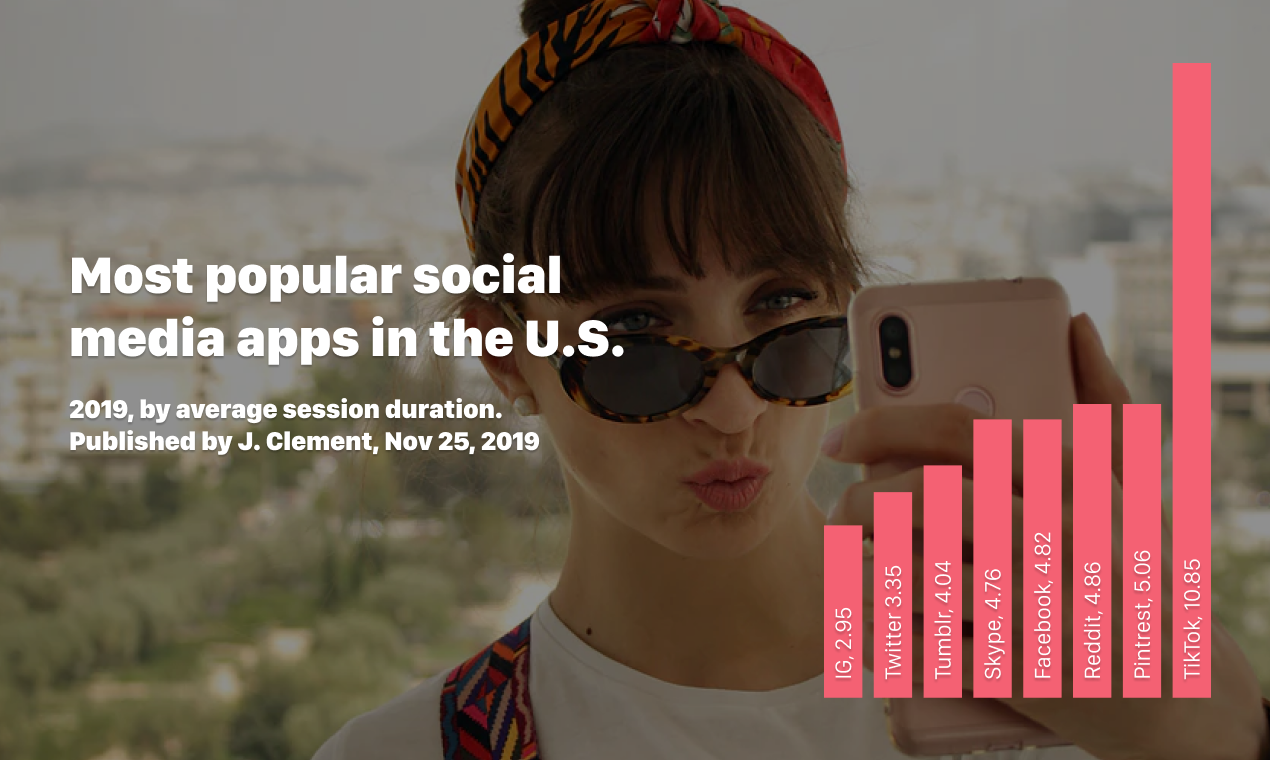The social media landscape is changing dramatically. During the last decade, the virtual currency that rewarded content creators and influencers was a currency made up of follows and likes. The short-form video app TikTok has pioneered an initially new methodology that uses an ever-changing algorithm to decide that their users consume.
TikTok is exceptionally good at recommending content, so much so that when a user opens the app, on average they will stay in it for over 10 minutes. Three times longer than Instagram. This demonstrates that algorithms based recommendations are much better than humans using like and follow filters. As TikTok's technology and user-based grow, we can expect this recommendation engine to get much better over time.

For a long time, it has been well known that vertical short-form video on mobile will be the future of mobile content. Snapchat found early success in this market with disappearing photos and video and then with their innovative story format. However, TikTok is currently winning over global audiences with its combination of native short-form video and algorithmic recommendations.
In this post, we are going to try and unpack to the best of our knowledge how this algorithm works, both for consumers and also for content creators. By understanding the mechanics behind the platform, we can start using this to better inform our content creation decisions and start to paint possible future changes to the landscape. Please note this is a high-level post for non-technical readers. Please also note that at any point in time, we can expect hundreds if not thousands of different recommendation algorithms running. Ready, lets go!
How does TikToks algorithm work for a content creator?
This is how a video is evaluated when it is posted on TikTok. Once a video is uploaded, TikTok will analyse your video using natural language processing and computer vision technology.
From the video itself, the information will be extracted to understand the content, audio, transcriptions to build up an understanding of the content and context of the videos. Here is a quote from Bytedance explaining how the algorithm works:
“Artificial intelligence powers all of Bytedance’s content platforms,” the spokesperson says. “We build intelligent machines that are capable of understanding and analyzing text, images and videos using natural language processing and computer vision technology. This enables us to serve users with the content that they find most interesting, and empower creators to share moments that matter in everyday life to a global audience.”

Now that TikTok knows some basics about the video, it will now boost the video to a small number of users. After booting the video, an evaluation will happen based on how the sample set of user interaction with the piece of content. Each metric that is tracked has an associated score that varies in value. Here is an estimated score hierarchy that awards content per user interaction.
Rewatch rate = 10 Points
Completion rate = 8 Points
Shares = 6 Points
Comments = 4 Points
Likes = 2 Points
As you can see from the above, per-user engagement rates are the top-rated metrics juxtaposed to likes and comment being the least. However, leaving a video playing on a loop is not going to make your videos go viral as this is calculated per user. This ranking system makes click farms redundant, a problem Facebook has been battling with for some time.

Now your video will be associated with a score. If your content is above a threshold, it will then be boosted to more TikTok users. Once again the process repeats again and again until it goes viral or until it no longer meets TikTok’s threshold. However, not all content should be designed to go viral. It is much more beneficial for your content to reach the right audiences than reach millions of users who dont dont connect with the content.
How does TikTok learn about you as a user?
Tiktok needs to learn as much as it can about you so that it knows what content to serve you. When a user downloads TikTok for the first time, they open the app and they are dropping right into the video feed without needing to signup. As well as this being a great UX decision, lowering the barrier to entry but also a smart one from a data collection point of view. At this point that app starts learning as much as it can about you. The first sequence of videos you now consume is designed to do two things.
1 - Keep you in the app
The first task is to keep you in the app for as long as possible. Only showing you videos that are classified as having high engagement rates to a wide audience, while also having the lowest exit rate.
2 - Understand what you like
The second is to learn from the pool of videos that you are consuming. What videos have you watched again on a loop, what is your completion rate per video, what profiles, hashtags, and trends have you looked at?
Using the same system as above, TikTok's algorithm will now start building a score based profile against your account. Every time you rewatch a video or consume the entire duration of the video, the algorithm takes note to inform its future suggestions. Here is the point system again.
Rewatch rate = 10 Points
Completion rate = 8 Points
Shares = 6 Points
Comments = 4 Points
Likes = 2 Points

Over time this profile gets more and more informed so that it can better recommend content to your needs.
Just like traditional TV programming, Location, time and day will also come into the recommendation algorithm. However, we are not going to explore these aspects of the algorithm in this post.
Final Thoughts
TikTok has managed to build an enormous video-first platform that is engaging users of all ages around the world with its pioneering content recommendation algorithm. User-generated content apps are only as good as the content on the platform. Therefore, it would be unfair not to praise TikTok’s video editing toolkit that allows its creators to make this engaging content. If filters were the key to unlocking better photos on Instagram. Then it would be fair to say that music and captions have been the key to unlock more engaging videos for TikTok.
If I had to give tips to anyone looking to make better content on TikTok, I would encourage content creators to optimise for a high rewatch and completion. As suspense, understanding and anticipation is the new clickbait. We would appreciate feedback on this post, and would love to add your ideas so please reach out.






